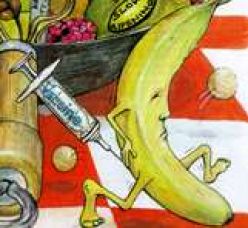Can vaccines be taken by mouth (orally)? Yes, we know this from the polio vaccine.
Can vaccines be produced by plants? This does not sound likely, but this is exactly what researchers have already achieved and what they are working on now. A group of researchers under Dr. Robert Rose from the University of Rochester in New York have been working on a number of vaccines with the help of genetic engineering.
The rationale is simple: in developing countries it can be difficult to keep vaccines refrigerated and to administer them by injection in a sterile manner through doctors and nurses. Also, the cost of production can be a major factor with regard to effectiveness of the vaccine on a population basis, if large parts of the community cannot afford the vaccine. For many vaccines to be effective more than 85% of the population have to be vaccinated. Newer research has shown that the protein envelope of a virus, which has a certain surface antigen associated with it, can be broken down into smaller subunits. According to a review article in The Medical Post ( March 4, 2003, page 29) Dr. Rose and his team have isolated the DNA sequence of the human papillomavirus (HPV) envelope in the early 1990’s. They were able to program potatoes to grow the protein subparticles that were immunologically active, but were not infective (no virus activity). In other words after genetic engineering the plant grows a vaccine, which can be safely consumed and the body mounts an immune response to this modified virus protein similar to the polio vaccine, but without a trace of virus.
As potatoes have to be cooked before consumption, some of the effectiveness of the vaccine gets lost. The researchers have since concentrated on other plants like apples, bananas, tomatoes and lettuce, which are eaten in the raw state. The various diseases that are being tested at the present time are: hepatitis B, respiratory syncytial virus (RSV), Norwalk virus, rotavirus and even the measles vaccine.
Dr. Charles Arntzen from the Arizona State University in Tempe, Arizona, has successfully applied the above technology to the production of plant vaccines against the Norwalk virus, the E.coli enterotoxin and hepatitis B in potatoes and tomatoes. He is taking this a step further as he is developing a technique of freeze-drying tomatoes containing the vaccine against the Norwalk virus, which allows the vaccine to be stored for long periods of time. When it is needed, it can be rehydrated and could also be delivered in pill form to vaccinate the population at risk at the time of an epidemic of enteritis the with Norwalk virus.
In summary, the new plant technology of vaccine production allows for much cheaper vaccine manufacturing. It eliminates the problems surrounding sterile injection techniques. The vaccine delivery by mouth allows for a much simpler distribution to a population at risk and can be done by lay persons. Also, a variety of vaccines will be able to be manufactured this way in future. The plant production is similar to the photocopying process where a template (the specific viral protein subparticle) is being copied by the plant. This allows for a number of vaccines against different strains of viruses to be programmed fairly quickly. It is an exciting new technique.
Here is a link to Influenza, which is one of the viral illnesses that can be significantly suppressed by vaccination.
Here is a link that explains the rationale of vaccinations and vaccination schedules.
Last edited October 25, 2014






